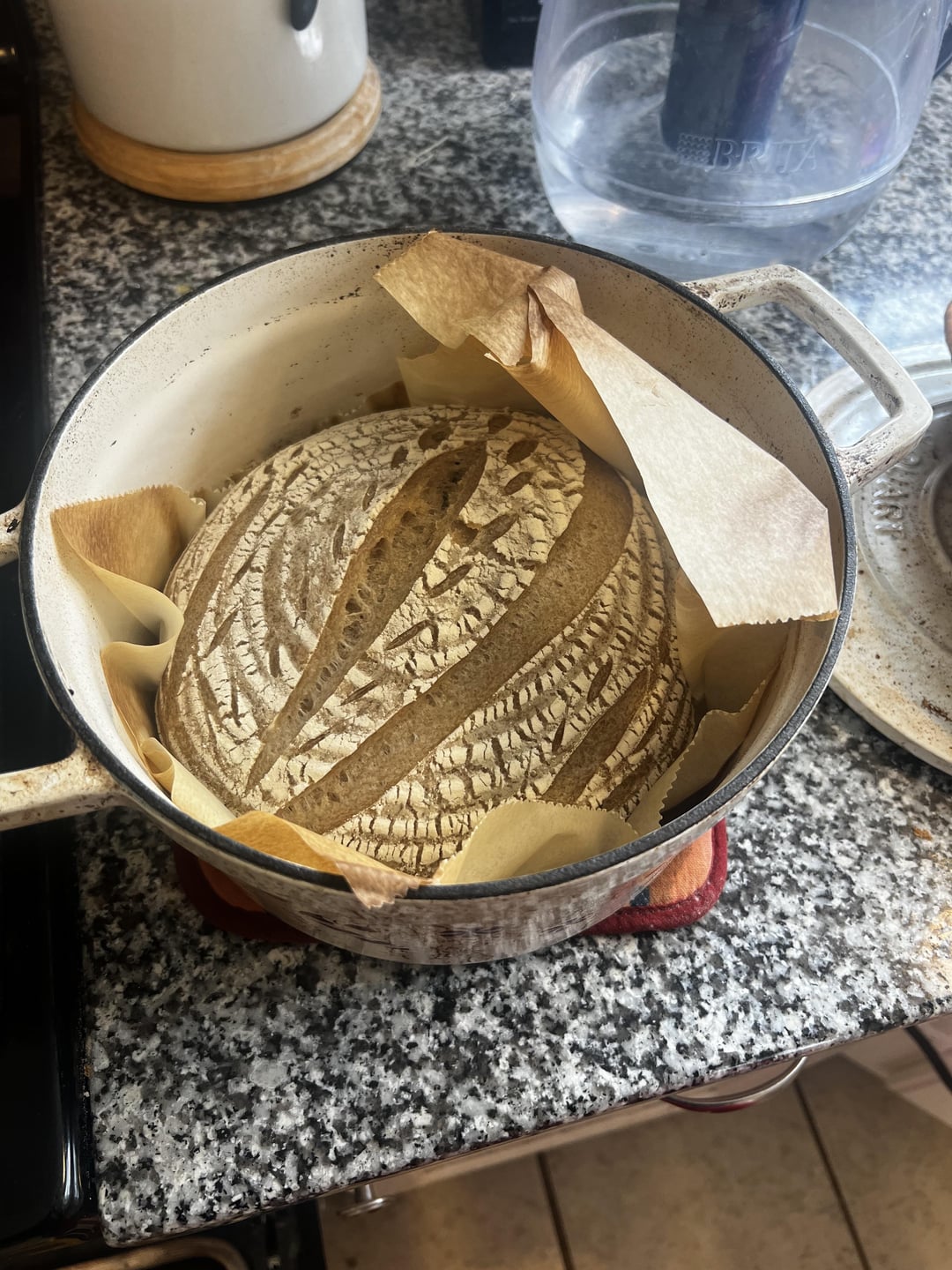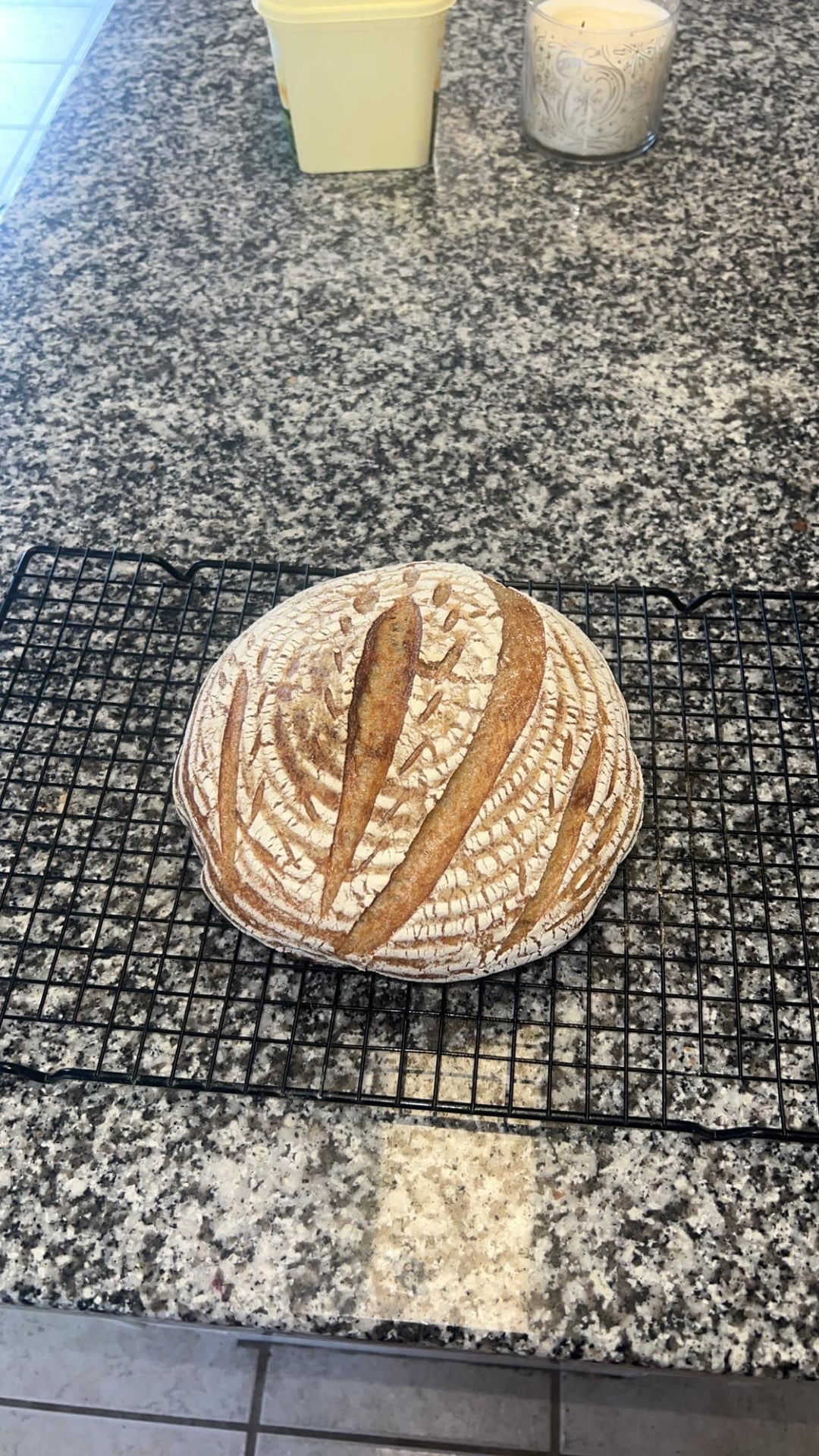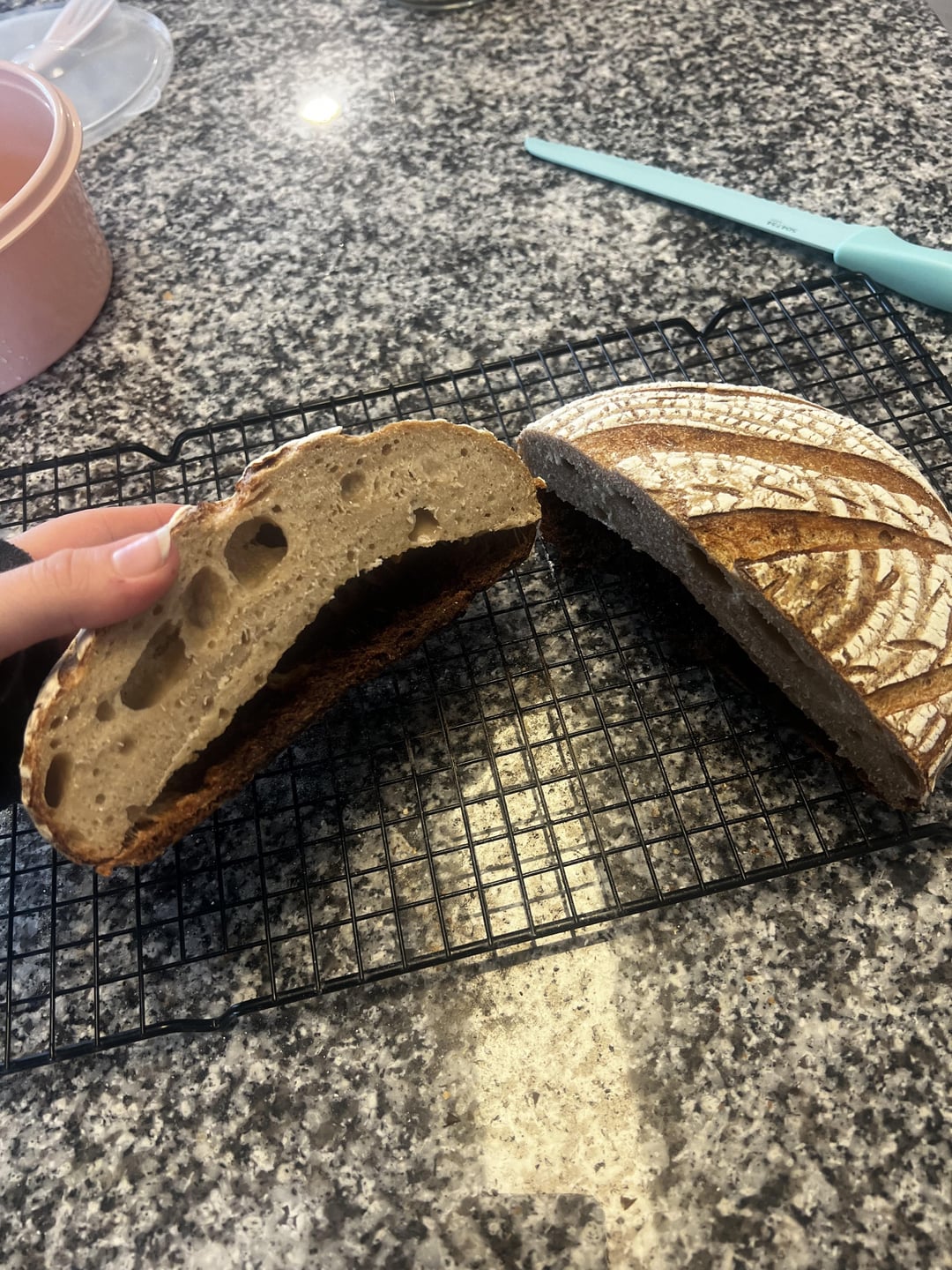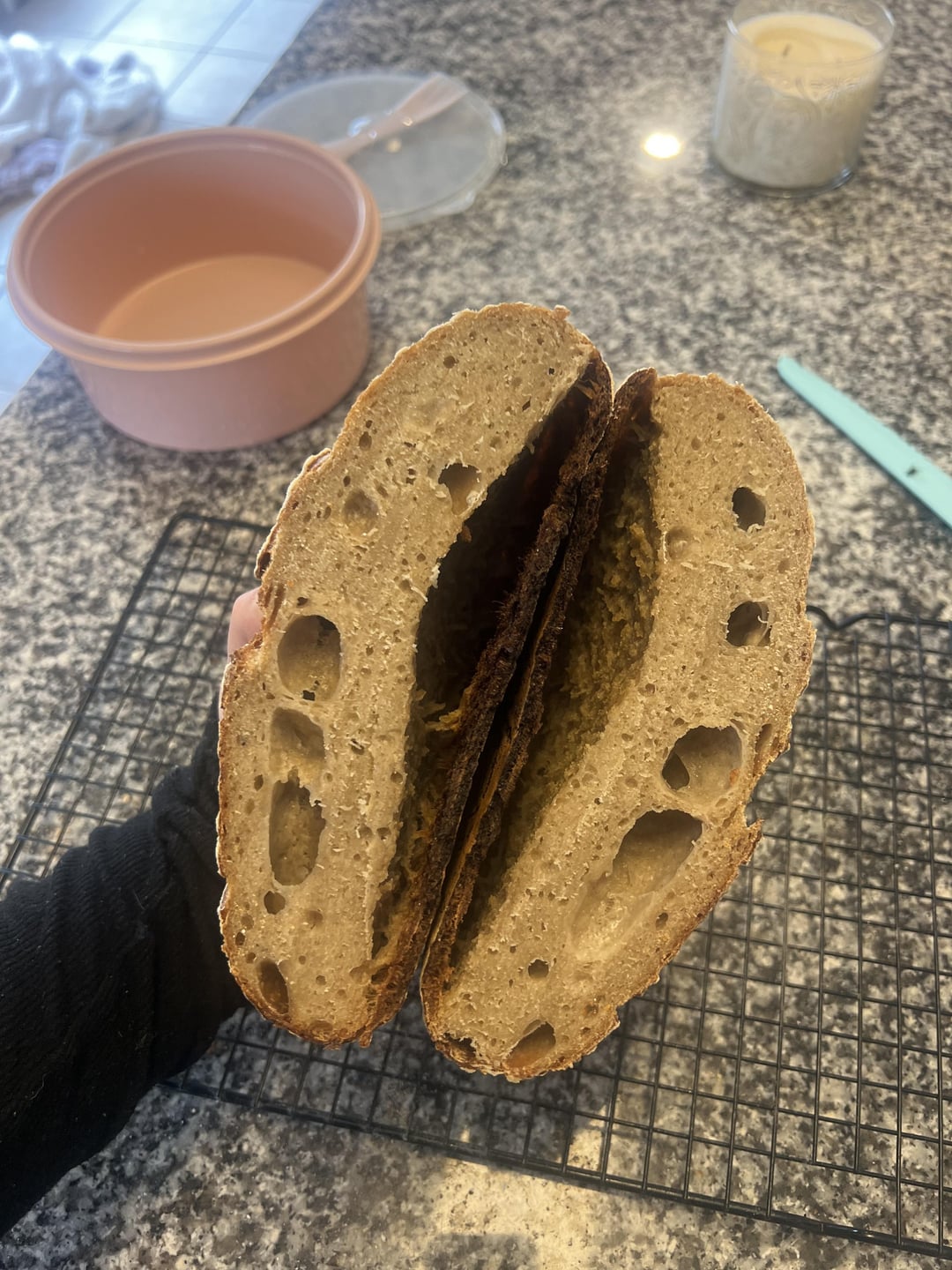



I posted a few nights ago getting some advice and I’ve tried just about everything that I was recommended. Using more/less water, proofing it longer, cold, proofing, etc…
I baked my loaf this morning and it looked gorgeous. But when I cut it open, it’s hollow. Never seen this one happen before. Anyone have any ideas?
Recipe:
100g Starter (ripe)
500g bread flour (I use King Arthur or whatever its called)
350g water (warm, filtered)
10g salt (I use fine sea salt)
I mix my starter and water first and then add the flour and salt.
Let sit for 1 hour
Then let it rise for about 2-3 hours
Pre-shape and place in floured Banneton. (This is where everything goes south it seems)
let rest for 1-2 hours. (THIS TIME I cold proofed it for about 20 hours. As recommended)
Preheat oven for 30-45 mins at 500 (with dutch oven inside)
Bake for 30 mins covered, drop temp to 450, bake for 20-25 or until golden.
I let it cool on a wire rack for 1-2 hours before cutting it.
by allyyylove

28 Comments
It looks to me like your starter might not be strong enough to properly ferment the dough. How often are you feeding , and at what ratio? Is your starter stored in a warm place. Usually the dense loafs are a result of under fermentation caused by a weak starter. If anything, try bulk fermenting in your oven with just the light on, or any warm place in your house between 80-90 degrees Fahrenheit. Hope this helps 🙂
Could be a BF time issue. 2-3 hours is really short unless you have your dough temp in the 80F range.
Messed up on my post which is causing some confusion.
**Recipe:**
100g Starter (ripe)
500g bread flour (I use King Arthur or whatever its called)
350g water (warm, filtered)
10g salt (I use fine sea salt)
I mix my starter and water first and then add the flour and salt.
Let sit for 1 hour
4x sets of stretch and folds, 30 mins apart **(2 hours total)**
Then let it rise for about 2-3 hours **(total rise time of 5-6hours)**
Pre-shape and place in floured Banneton. (This is where everything goes south it seems)
let rest for 1-2 hours. **(THIS TIME I cold proofed it for about 20 hours. As recommended by previous post.)**
Preheat oven for 30-45 mins at 500 (with dutch oven inside)
Bake for 30 mins covered, drop temp to 450, bake for 20-25 or until golden.
I let it cool on a wire rack for 1-2 hours before cutting it.
If it’s not a starter issue I’d definitely bulk ferment longer, aim for at least 5-6 hours
I’ve been having good success with feeding starter before bed, mix/s+fs in the morning, let it sit on the counter til dinner time to preshape.
Mmmm this looks like a weak starter problem. It by all means can still proof the dough but looks like it had absolutely ran out of energy by the time it came to baking.
My thought, as someone who is not a sourdough expert, but has been cooking for 15 years, is that maybe it could have to do with your hot ass dutch oven.
In my head it stands to reason that cold dough hitting that super hot pan could cause the bottom to bubble that quickly before the rest of the dough rises at all. Probably also has to do with some imperfection in gluten development and/or shaping but maybe a slightly cooler oven and some protection from that ripping heat may have allowed it to still bake more regularly.
Perhaps try a 450-475 degree oven for a bit less time, and definitely put 1 or 2 baking sheets between your dutch oven and the heating element.
Not an expert but do you have a small oven? Or was your dutch oven close to the bottom? It kind of looks like it cooked (and then burnt) the bottom of your loaf very quickly, which could have affected the rest of the baking. Just an additional thought.
If you can, try to put a cookie sheet under your dutch oven on a rack below it, to help prevent so much direct heat to the bottom of your dutch oven.
Too hot of a base and under fermented.
Edit. Personally, I would BF for longer and try again at the same temperature just in case it has more to do with the gas having nowhere to go due to under fermentation. If then you still get a large bottom bubble, then drop the temp.
It looks like your only bulk fermentation (between autolyse and final shape) is 2-3 hours. This is not nearly enough time in my experience. Most bulk ferment will be between 6-8 hours but in cooler kitchens(like my own) it can take 10-12 hours. And that’s all before a cold proof. Because it’s so temperature sensitive, you shouldn’t gauge it by the hour but rather by a variety of signs. Dough should be tacky, and able to pull away from your fingers, windowpane should be present if it’s properly strengthened, and a minimum of 30% rise but I find getting in the 70% range performs best for my loaves. I have a couple questions too, are you doing anything to strengthen your dough and develop the gluten during bulk ferment? Coil folds, stretch and folds, etc? The texture of the dough changes drastically during this process and I wouldn’t shape and put in bannetons until you see that shift in the gluten and dough.
Also do you use a clear straight sided container to accurately assess the dough rise? A bowl is not an accurate gauge.
My recipe, timing, and ambient temperature are very similar to yours and my first loaf was a tad underprooofed but nothing like that.
To clarify do you pre-shape, let rest, and then shape again before going in the banneton? What size banneton? Also when you say let rest 1-2 hours after putting it in the banneton, is that in the fridge or on the counter?
It looks underproofed and undercooked if you ask me
This feels like your starter is not in a good place. Can you snap some pics of it next time around?
Seems like your almost there. I download and paid for the app called Bread Boss. It’s really detailed and accounts for everything. Maybe try that. It’ll save you months of touch and go. Just a thought.
I agree with everyone saying that it looks underproofed. I’m trying to follow your process in the comments and, from what I’ve gathered, your bulk ferment time is pretty short and very hot. I’m still pretty new but I’ve never seen a recommendation to bulk at 90f. I really don’t pay much attention to rise until after my stretch and folds. What container are you using? Does it have markings on it to really tell if it’s doubled? I bulk at 78-80f and I barely see any activity in the first few hours.
Purdy leaf designs but shit crumb. My advice is to pursue the artist in you and leave the sourdough making to the sourdough makers.
I don’t see any details on how you’re feeding the starter, but sorry if I missed them! I realize you aren’t discarding anything because you’re baking with it.
How much starter do you have before you feed it, and what ratio are you feeding it? I typically do 1:3:3, so like 25g starter, 75g bread flour, 75g warm water.
Also, what type of flour do you feed your starter? Are you using the King Arthur bread flour?
I would also just stretch out that bulk ferment. Sometimes mine is sitting out for 9 hours, and it still doesn’t end up overproofed. I wait until I see a decent amount of bubbles in the dough. I don’t really go by whether it’s doubled or not. My best loaves are the ones I forget I’m making and let bulk ferment the longest.
I think regardless of duration, this is under proof. Do you bulk ferment in any container where you can see the side and bottom of the dough while rising so you can observe? It needs to still have some rise during bulk
How long are you mixing for? I use a stand mixer and medium mix for about 15 minutes. Check out this video. https://youtu.be/xETLp7dmV7k?si=E1CKkZ7cVFGa-TE7
I don’t think your bulk ferment is long enough. After my dough is mixed + stretch and folds (which takes about 3 hours) , my dough sits on my counter for like 8 hours before it’s gotten to a 75% rise. Thats when I shape and pop into the fridge. Thats 11 hour total ferment (from the start of mixing with starter). Your total looks about 6 hours. 2-3 hours after stretch in folds is verrrry short amount of time. I would use a square container to look for rise. Bowl shapes won’t accurately show the rise. If your house sits around 70-73 degrees, you don’t need to bulk in the oven. That’s what my house is and I bulk on the counter. Use the aliquot method again and only go by rise of that. Based on your timeline, underproofed is the most likely cause. Good luck 👍🏼
I often bulk fetment overnight. If there’s one thing I’ve learnt it’s that sourdough is very resilient. Over fermentation is almost always better than under fermentation. Patience pays.
Other than that I think you could up the water content slightly
Use Foodgeek basic sourdough recipe. Post pictures of your starter before you add it to the levain. Use amount for rise, not time. Record the temp in the area that you’re bulking in.
underproofed or weak starter
This is when you WANT the book to be judged by its cover.
Yeah looks under proofed. Usually let mine sit for about 6 hours for BF then final shape into Banneton then over night in the fridge, and straight into a 450 degree preheated Dutch oven.
If you can put a shallow pan under your dutch oven, will help distribute the heat and will brown less on bottom.
It’s so hard to tell without being there for the process but I’m going to share my process and you see if maybe something is wildly different?
I’m not very technical on my bakes as I could be and I have never had this is issue.
I sometimes put my starter in the oven when it’s cold but I don’t leave the light on for longer than 10 minutes. I don’t want my starter higher than 80degrees F. Sourdough CAN be slightly rushed but it will directly affect the PH of your starter and therefore your dough.
Average loaf
20% starter
100% bread flour organic from a mill in my state with a protein % of 12-14
2.5% salt
78% water
Mix everything but salt til shaggy.
Let sit for one hour
Add salt and mix again
2-4 Coil folds (every 30/40 minutes)
Once my dough is kind of tense and less sticky I stop and bulk for another 4 hours or so but depending on the temps I could do 5 or 6.
I then portion if doing multiple or just shape the single loaf. I don’t always preshape unless it’s a higher hydration dough and needs a little more tension.
Into the fridge for 12-18 hours.
Preheat oven to 500 with whatever you’re baking in/on. I usually have to preheat an hour to make sure the sheet/Dutch oven is actually hot.
Score my dough, put it in the oven and turn the oven down to 450.
Bake 20 minutes with steam
20 minutes without steam
I also will check about halfway through the second half to make sure my bottoms not getting too dark.
Hope that helps! The process can be annoying sometimes but once ya figure it out it gets a lot easier! Happy baking
I’m not seeing any stretch and folds in your recipe. Are you doing those very 15-30min after the initial mixing of ingredients? You need develop some gluten during that time. Otherwise your bread won’t have enough strength.
Was your starter doubled and very active?